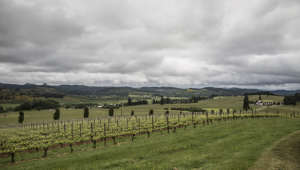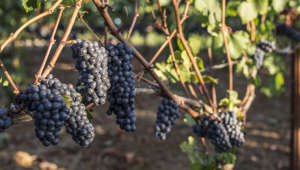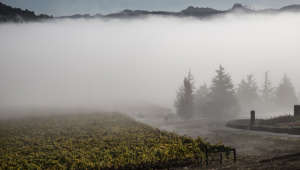Halfway between the equator and the North Pole, along the 45th parallel, are located two of the world’s most heralded wine regions. Separated by more than 5,000 miles and 18 centuries of winemaking tradition, Burgundy, France, and the Willamette Valley in Oregon have at least one wine-defining characteristic in common: Climate.
Climate is the second dimension of terroir that we’re exploring, and is important because of how it affects flavor development in fruit. Terroir, which has been defined as “sense of place,” encompasses those aspects of a vineyard that are fixed, such as soil, elevation, sun exposure and land contour. Russell Bevan of Bevan Cellars in Napa Valley has called terroir “Mother Nature and dirt.” (And terroir + personality = the finished wine. But more on that later.) In our last blog we talked about dirt; this time, we’ll turn our attention to Mother Nature and the unique climate characteristics that distinguish Oregon – and Burgundy – wines.
Winemaking in Burgundy can be traced back some 2,000 years. Oregon’s first recorded vineyard was established in the 1850s in Jacksonville in southern Oregon, even before statehood in 1859. In 1904 a wine from Forest Grove won a silver medal at the World’s Fair in St. Louis. Interrupted by prohibition, the industry languished until the 1960s. Once the industry caught on, it grew rapidly. Today the state is home to more than 700 wineries and 1,000 vineyards. As different as Oregon is from France in many obvious ways, both are known for wine and in particular for fine Pinot Noir.
In her book “Wine Folly,” Madeline Puckette writes that “Region affects pinot noir perhaps more than any other grape.” Oregon’s suitability for producing wine and its similarity to Burgundy’s growing conditions may not have been immediately evident due to a couple of characteristics the regions do not share: the amount of rainfall, and proximity to the coast. Eugene averages 60% more rainfall than Burgundy and is 150 miles closer to the ocean.

According to King Estate Winery Operations and Viticulture Director Ray Nuclo, these differentiating factors could be mitigated by the fact that our rainfall occurs primarily in winter, outside the growing season, and the presence of the Coast Range which moderates the ocean’s influence. Rains that collect over the Pacific Ocean and the coastline are dumped in the mountain range before they reach the valley. In fact the marine air has proven to be an asset during the peak summer ripening season, keeping the vineyard from heating up too quickly in the mornings and providing breezes later in the day to mitigate late afternoon high temperatures. The large diurnal, or daily, temperature swings of up to 35 degrees for which western Oregon is known serve to enhance flavor development in wine grapes and other fruits.
Respected British wine critic Jancis Robinson notes that “the Pinot Noir grower’s lot is not an easy one.” The grape is notoriously finicky, delicate and less hardy than, say, its Cabernet Sauvignon counterpart. A cool-climate grape, Pinot Noir tends to ripen early so it thrives in a shorter growing season like Oregon’s with temperatures that fluctuate widely during the intense hot days in late summer, close to harvest, when flavor development is at its peak but before acid levels drop off. Those long, hot days, moderated by the cooling element of mountains, ocean and elevation, result in wines that are interesting and complex, made even more desirable because of the grape’s reputation for being difficult to grow.

The interplay between elevation and climate adds another dimension to terroir. At 800 to 1,100 feet, King Estate is at the high end of the range for growing Pinot Noir and Pinot Gris, the two wines on which King Estate has built its reputation. With higher elevation comes challenges – threat of frost, in particular. Here King Estate’s somewhat hilly terrain offers an advantage. Since cold air drains downhill, planting on the slopes of the hills helps avoid frost.
The 1,033-acre estate is not just one “monoclimate” but rather is a series of some 10 to 12 micro-climates, each with its own unique characteristics (elevation, aspect, contour) and requirements. Viticulture Director Ray Nuclo and his team know the vineyard intimately and plan carefully to get the best possible fruit out of each block. For example, at lower elevations where cold air tends to collect we make greater use of hanging trellises that keep the grapes 18 inches higher off the ground. That may not sound like a lot but it’s often enough to buffer the grapes from a layer of cold air that settles on the ground. Cold air sinks as hot air rises, only to cool down as it reaches higher elevations. At higher spots in the vineyard where the air has cooled is a good place for grapes that ripen earlier and don’t need as much prolonged heat to bring out the grape’s full flavor. A detailed knowledge of the climate unique to our vineyard helps our viticulturists and winemakers make the most of this precious Oregon land.

Experts can argue – and do – about which aspects of terroir are more important. Is soil the critical factor, or is it climate? Or is it terrain, or tradition? Or does it vary by region? As far as Ray and King Estate are concerned, it’s all of the above. It’s how the various elements interplay with one another that makes each wine special and distinctive. When it comes to terroir, the sum truly is greater than the parts.
Jancis Robinson asserts that Pinot Noir is unique in its ability to “communicate the difference in terroir.” See for yourself the next time you enjoy Oregon Pinot Noir. Is it rustic and earthy, in Burgundian style, or lighter and fruitier in the Oregon fashion? Even if you can’t detect the difference, we promise it will be fun trying.
